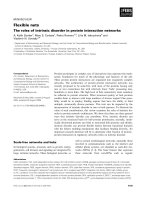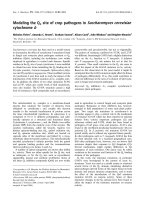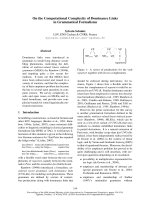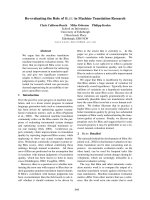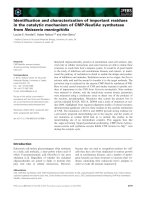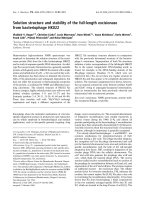Báo cáo khoa học: " Cytokine profiles as markers of disease severity in sepsis: a multiplex analysis" pot
Bạn đang xem bản rút gọn của tài liệu. Xem và tải ngay bản đầy đủ của tài liệu tại đây (202.6 KB, 8 trang )
Open Access
Available online />Page 1 of 8
(page number not for citation purposes)
Vol 11 No 2
Research
Cytokine profiles as markers of disease severity in sepsis: a
multiplex analysis
Fernando A Bozza
1,2
, Jorge I Salluh
3,4
, André M Japiassu
1,2,5
, Marcio Soares
4
, Edson F Assis
6
,
Rachel N Gomes
6
, Marcelo T Bozza
7
, Hugo C Castro-Faria-Neto
6
and Patrícia T Bozza
6
1
ICU, Instituto de Pesquisa Clínica Evandro Chagas, Fundação Oswaldo Cruz, Av Brasil 4365, Rio de Janeiro, Brazil
2
ICU, Hospital Universitário Clementino Fraga Filho, Universidade Federal do Rio de Janeiro, Rio de Janeiro, Brazil
3
ICU, Hospital Barra D'Or, Av. Ayrton Senna, 2541, Rio de Janeiro, 22775-001, Brazil
4
ICU, Instituto Nacional do Câncer, Rio de Janeiro, Brazil
5
ICU, Hospital Quinta D'Or, R. Almirante Baltazar 435, Rio de Janeiro, 20941-150, Brazil
6
Laboratório de Imunofarmacologia, Departamento de Fisiologia e Farmacodinâmica, IOC, Fundação Oswaldo Cruz, Av Brasil 4365, Rio de Janeiro,
21045-900, Brazil
7
Departamento de Imunologia, Instituto de Microbiologia, Universidade Federal do Rio de Janeiro, Rio de Janeiro, RJ, 21941-590, Brazil
Corresponding author: Patrícia T Bozza,
Received: 3 Jan 2007 Revisions requested: 16 Feb 2007 Revisions received: 3 Apr 2007 Accepted: 21 Apr 2007 Published: 21 Apr 2007
Critical Care 2007, 11:R49 (doi:10.1186/cc5783)
This article is online at: />© 2007 Bozza et al.; licensee BioMed Central Ltd.
This is an open access article distributed under the terms of the Creative Commons Attribution License ( />),
which permits unrestricted use, distribution, and reproduction in any medium, provided the original work is properly cited.
Abstract
Introduction The current shortage of accurate and readily
available, validated biomarkers of disease severity in sepsis is an
important limitation when attempting to stratify patients into
homogeneous groups, in order to study pathogenesis or
develop therapeutic interventions. The aim of the present study
was to determine the cytokine profile in plasma of patients with
severe sepsis by using a multiplex system for simultaneous
detection of 17 cytokines.
Methods This was a prospective cohort study conducted in four
tertiary hospitals. A total of 60 patients with a recent diagnosis
of severe sepsis were included. Plasma samples were collected
for measurement of cytokine concentrations. A multiplex
analysis was performed to evaluate levels of 17 cytokines (IL-1β,
IL-2, IL-4, IL-5, IL-6, IL-7, IL-8, IL-10, IL-12, IL-13, IL-17,
interferon-γ, granulocyte colony-stimulating factor [G-CSF],
granulocyte-macrophage colony-stimulating factor, monocyte
chemoattractant protein [MCP]-1, macrophage inflammatory
protein-1 and tumour necrosis factor-α). Cytokine
concentrations were related to the presence of severe sepsis or
septic shock, the severity and evolution of organ failure, and
early and late mortality.
Results Concentrations of IL-1β, IL-6, IL-7, IL-8, IL-10, IL-13,
interferon-γ, MCP-1 and tumour necrosis factor-α were
significantly higher in septic shock patients than in those with
severe sepsis. Cytokine concentrations were associated with
severity and evolution of organ dysfunction. With regard to the
severity of organ dysfunction on day 1, IL-8 and MCP-1
exhibited the best correlation with Sequential Organ Failure
Assessment score. In addition, IL-6, IL-8 and G-CSF
concentrations during the first 24 hours were predictive of
worsening organ dysfunction or failure of organ dysfunction to
improve on day three. In terms of predicting mortality, the
cytokines IL-1β, IL-4, IL-6, IL-8, MCP-1 and G-CSF had good
accuracy for predicting early mortality (< 48 hours), and IL-8 and
MCP-1 had the best accuracy for predicting mortality at 28
days. In multivariate analysis, only MCP-1 was independently
associated with prognosis.
Conclusion In this exploratory analysis we demonstrated that
use of a multiple cytokine assay platform allowed identification
of distinct cytokine profiles associated with sepsis severity,
evolution of organ failure and death.
APACHE = Acute Physiology and Chronic Health Evaluation; AUROC = area under the receiver operating characteristic curve; CI = confidence inter-
val; ELISA = enzyme-linked immunosorbent assay; G-CSF = granulocyte colony-stimulating factor; IFN = interferon; IL = interleukin; MCP = monocyte
chemoattractant protein; ROC = receiver operating characteristic; SOFA = Sequential Organ Failure Assessment; TNF = tumour necrosis factor.
Critical Care Vol 11 No 2 Bozza et al.
Page 2 of 8
(page number not for citation purposes)
Introduction
Identifying high-risk patients with sepsis is a great challenge in
the care of critically ill patients [1,2]. Most decisions in patients
with severe sepsis are based on clinical and laboratory data
with poor accuracy [3]. Therefore, efforts to enhance knowl-
edge of the pathophysiology of systemic inflammation and to
identify more accurate predictors of prognosis are important
[4,5]. Ideally, biomarkers should provide valuable information
regarding diagnosis and prognosis, and should permit one to
monitor the patient's response to treatment [6].
Although for decades prognostication in critically ill patients
has been achieved by quantifying the degree of physiological
derangement, such indices do not take into account the
patient's specific alteration in immune status. Recently, a new
clinical staging system for sepsis was proposed [7], and in this
model identification of biomarkers that play central roles in the
pathogenesis of sepsis is crucial [8]. Cytokines are proteins
that are secreted by components of the innate and adaptive
immune systems, and they act as effectors or modulators of
inflammatory response, which in turn play prominent roles in
the development of sepsis [9].
New technologies for cytokine quantification have recently
been developed [10-12]. Among those, the multiplex analysis
system, which uses a combination of fluorescently dyed micro-
spheres associated with a two-laser flow cytometry based sys-
tem [13], permits the simultaneous analysis of up to 100
different biomolecules (proteins, peptides, or nucleic acids) in
a single microplate well using small samples [14]. Recent
studies indicate that this multiplex analysis system could be
used to measure cytokine concentrations in lipopolysaccha-
ride-stimulated human plasma samples, demonstrating that it
would be feasible to detect and quantify cytokines and other
potential biomarkers in a complex milieu such as human septic
plasma [15].
The aim of the present study was to determine the cytokine
profile in plasma of patients with severe sepsis by using a mul-
tiplex system that permits simultaneous detection of 17
cytokines. We conducted an exploratory analysis and found
that the multiple cytokine assay platform was able to identify
distinct cytokine profiles associated with sepsis severity, evo-
lution of organ failure and death.
Materials and methods
Patients
Our ethics committee approved the present study, and signed
informed consent was obtained from all participants. We pro-
spectively included 60 patients who, based on strong suspi-
cion of infection, were admitted to the medical-surgical
intensive care units at the Hospital Universitário Clementino
Fraga Filho-UFRJ, Hospital Espanhol, Hospital Barra D'or and
Hospital Quinta D'or (Rio de Janeiro, Brazil). Patients were eli-
gible for inclusion if they fulfilled criteria for systemic inflamma-
tory response syndrome and had an obvious source of
infection. Systemic inflammatory response syndrome, severe
sepsis and septic shock were defined in accordance with the
American College of Chest Physicians/Society of Critical
Care Medicine Consensus Conference [16]. Severity of ill-
ness was assessed by calculating the Acute Physiology and
Chronic Health Evaluation (APACHE) II score for the first 24
hours [17] and the Sequential Organ Failure Assessment
(SOFA) score [18] on days 1 and 3. Based on variations in the
SOFA score between days 1 and 3, patients were categorized
as 'improved' if the SOFA category decreased by 1 point or
more, or 'not improved' if the category remained the same or
increased by 1 point or more (modified from Levy an cowork-
ers [19]). Patients were excluded in case of death within six
hours of admission or if they were under 18 years old. None of
the patients received anti-inflammatory agents, corticoster-
oids, or other sepsis-modifying agents before enrolment or
during the study period. Early mortality was defined as death
occurring during the first 48 hours. The main outcome meas-
ure of interest was 28-day mortality.
Multiplex cytokine assay
Blood samples were collected between 10:00 and 12:00
hours using an arterial line or a peripheral vein. Blood was put
on ice and plasma was collected by centrifugation at 800 g for
15 min at 4°C, aliquoted and stored at -70°C until analysis. A
multiplex cytokine kit (IL-1β, IL-2, IL-4, IL-5, IL-6, IL-7, IL-8, IL-
10, IL-12, IL-13, IL-17, IFN-γ, granulocyte colony-stimulating
factor [G-CSF], granulocyte-macrophage colony-stimulating
factor, monocyte chemoattractant protein [MCP]-1, macro-
phage inflammatory protein-1 and tumour necrosis factor
[TNF]-α) was obtained and the assay performed in accord-
ance with the manufacturer's instructions (Bio-Rad, Hercules,
CA, USA).
In brief, the appropriate cytokine standards and samples (50
μl), diluted in plasma dilution buffer, were added to wells of a
filtered plate. The samples were incubated with 50 μl of the
antibody-coupled microsphere set (2,000 beads/well) at room
temperature for 30 min on a plate shaker (set to 300 rpm) in
the dark and filter washed three times with 100 μl wash buffer.
Freshly diluted secondary/detection antibody (25 μl/well) was
added to the wells and then incubated at room temperature on
a plate shaker for 30 min in the dark and filter washed three
times with 100 μl wash buffer. Fifty microlitres of streptavidin-
PE (16 μg/ml in assay buffer) was added to the wells, and
incubation at room temperature continued for the first 10 min
on a plate shaker. Unbound analytes were filtered through the
wells using the vacuum manifold and the bound beads were
washed three times with 100 μl/wash buffer. After the last
wash step, 125 μl of assay buffer was added to each well and
the plate placed for 1 min on a plate shaker set at 500 rpm and
then for 3 min at the reduced speed of 300 rpm.
Available online />Page 3 of 8
(page number not for citation purposes)
Fifty microlitres of sample was analyzed on the Bio-Plex sys-
tem (Bio-Rad) in accordance with the manufacturer's instruc-
tions. Data analyses for all assays were performed using the
Bio-Plex Manager software. Cytokine detection using multiplex
bead array assays exhibits high degrees of intra-assay (< 10%
variation) and inter-assay (10% to 20% variation) precision
[13,20]. Cytokine detection by Luminex xMAP technology is
comparable to that with enzyme-linked immunosorbent assay
(ELISA; correlation coefficient r ranges from 0.75 to 0.99)
[13,20,21]. Accordingly, when we compared IL-6 detection by
Luminex technology and by conventional ELISA (R&D System,
Minneapolis, MN, USA) in 31 septic patients, we observed
good correlation between the two technologies (r = 0.815; P
< 0.001).
Statistical analysis
Statistical analyses were performed using SPSS for Windows
10.0 (SPSS Inc., Chicago, IL, USA) and GraphPad Prism ver-
sion 3.0 for Windows (GraphPad Software, San Diego, CA,
USA). Numeric variables are expressed as median (interquar-
tile range) and were assessed using Mann-Whitney U-test and
Kruskal-Wallis test. Dichotomous variables were analyzed
using χ
2
and Fisher's exact test (with Yates correction as indi-
cated). Spearman analysis was employed top detect correla-
tions among continuous variables. Receiver operating
characteristic (ROC) curves were constructed by plotting the
sensitivity versus 1 – specificity, and area under the ROC
curve (AUROC) was used to evaluate the ability of each
cytokine level to discriminate survivors from nonsurvivors and
to predict the evolution of organ dysfunction [22]. Univariate
and multivariate logistic regression were used to identify fac-
tors associated with hospital mortality. Linearity between con-
tinuous variables and the dependent variable was
demonstrated using locally weighted scatterplot smoothing
(Lowess).
Cytokine concentrations required a log transformation to sat-
isfy the linearity assumption. Variables yielding P values below
0.2 by univariate analysis were entered into a forward multivar-
iate logistic regression analysis [23]. Multivariate analysis
results were summarized by estimating odds ratios and
respective 95% confidence intervals (CIs). The other covari-
ates were entered into the model with critical entry and
removal P values of 0.05 and 0.1. Effects on covariate coeffi-
cients were also considered. Two-tailed P values below 0.05
were considered statistically significant.
Results
Patients characteristics
Sixty patients were included in this study; 31 (51.7%) patients
survived and 29 (48.3%) died. Demographic, clinical and
microbiological data for the survivors and nonsurvivors are
summarized in Table 1. Patients who died had higher
APACHE II and SOFA scores, as expected, compared with
survivors. The leading source of infection was the respiratory
tract. Micro-organisms were isolated in 50 out of 60 septic
patients (83.3%), with a predominance of Gram-negative bac-
teria (76.0%).
Cytokine concentrations
When data from all 1,020 assays were analyzed, the multiplex
cytokine system was able to detect plasma cytokines in 710
(69.6%) assays. (Here we define 'assay' as each cytokine
measured, which was performed on each individual plasma
sample.) Concentrations of IL-6, IL-8, IL-10 and macrophage
inflammatory protein-1 were detectable in more than 95% of
individual assays.
We compared cytokine concentrations among patients with
severe sepsis and septic shock, and observed that concentra-
tions of IL-1β, IL-6, IL-7, IL-8, IL-10, IL-13, IFN-α, MCP-1 and
TNF-α were significantly increased in septic shock as com-
pared with severe sepsis (Table 2).
Cytokine concentrations and evolution of organ failures
We evaluated the relation of cytokine concentrations to the
severity of acute organ dysfunction, as assessed using the
SOFA score. We observed a positive correlation between the
cytokines IL-1β, IL-6, IL-8, IL-10, MCP-1 and G-CSF, and
SOFA score on day 1. The best degrees of correlation were
observed for IL-8 and MCP-1 (r = 0.50 and 0.43, respectively;
P < 0.01). In addition, we investigated the ability of cytokines
to predict early adverse outcomes, defined as death occurring
during the first 48 hours or failure of organ dysfunction to
improve by day 3. Nine patients (15%) died within the first 48
hours. IL-1β, IL-4, IL-6, IL-8, MCP-1 and G-CSF had good
accuracy for predicting the occurrence of early mortality (< 48
hours). The AUROC for all six cytokines are presented in Table
3. Higher concentrations of IL-6, IL-8 and G-CSF (on day 1)
were present in patients whose organ dysfunction worsened
or failed to improve by day 3 (Figure 1). As expected, mortality
at day 28 was significantly higher in patients whose SOFA
score on day 3 did not improve as compared to those whose
SOFA score improved (53.6% versus 21.7%; P = 0.02).
Predictive value of cytokines for severe sepsis 28-day
mortality
The cytokine plasma concentrations of survivors and nonsurvi-
vors (death by 28 days) are shown in Table 4. Of the 17
cytokines studied, five (IL-1β, IL-4, IL-6, IL-8 and MCP-1) were
significantly higher in nonsurvivors. Among the 17 cytokines,
only six exhibited AUROC values above 0.6, and discrimina-
tion was considered adequate (AUROC > 0.7) only for IL-8
and MCP-1 (Table 5). In multivariate analysis, a base model
including APACHE II score and cytokines with AUROC above
0.7 was created. Age (years), IL-6, IL-1β, IL-4 and IL-10 were
forced (each variable was forced in separately) into the final
model and were not selected. Among the covariates, only
MCP-1 and APACHE II score were independently associated
with increased mortality (Table 6). The final model, including
Critical Care Vol 11 No 2 Bozza et al.
Page 4 of 8
(page number not for citation purposes)
MCP-1 and APACHE II score, had good discrimination
(AUROC = 0.888, 95% CI = 0.804 to 0.971; P < 0.001).
AUROC of the multivariate model was slightly higher than
those of APACHE II score (0.848, 95% CI = 0.752 to 0.944)
and MCP-1 (0.715, 95% CI = 0.586 to 0.844) alone (Figure
2). Nonetheless, the 95% CIs were rather wide, resulting in
significant overlap of AUROC findings.
Table 1
Patient characteristics
Characteristic All patients (n = 60) Survivors (n = 31) Nonsurvivors (n = 29)
Age (years)
a
64 (51–75) 55 (48.5–81.50) 64.0 (58.5–73.5)
Gender (male/female) 36/24 19/12 17/12
APACHE II score (points)
a
20 (17–23) 17.0 (14.5–20.0) 22.0 (20.0–28.0)*
SOFA score on day 1
a
9 (6–11) 7 (5–9) 11 (8.5–12)*
SOFA score on day 3
a
7 (5–10) 6 (3–7) 10.5 (8.5–12.5)*
Septic shock 46/60 19/31 27/29
Sites of infection
Lung 33 (55.00%) 20 (64.52%) 13 (44.83%)
Abdomen 15 (25.00%) 5 (16.13%) 10 (34.48%)
Blood 5 (8.33%) 3 (9.68%) 2 (6.90%)
Other 7 (11.66%) 3 (9.68%) 4 (13.79%)
Microbiological data
Gram-negative bacteria 37 (61.66%) 18 (66.67%) 19 (82.50%)
Gram-positive bacteria 7 (11.66%) 5 (18.52%) 2 (8.69%)
Polybacterial 4 (6.66%) 2 (7.41%) 2 (8.69%)
Fungi 2 (3.33%) 2 (7.41%) 0 (0%)
Positive cultures 50 (83.33%) 27 (87.10%) 23 (76.00%)
Positive blood cultures 12 (20.00%) 8 (29.63%) 4 (17.39%)
Unless otherwise stated, values are expressed as number or number (%).
a
Median (interquartile range). *P < 0.05, survivors versus nonsurvivors.
APACHE, Acute Physiology and Chronic Health Evaluation; SOFA, Sequential Organ Failure Assessment.
Table 2
Plasma cytokine concentrations: severe sepsis versus septic shock
Cytokine Severe sepsis (n = 14) Septic shock (n = 46) P value
a
IL-1β 0.17 (0.00–0.79) 1.22 (0.01–7.33) 0.01
Il-6 1027 (583.1–4854) 5632 (1889–12170) 0.007
IL-7 0.00 (0.00–0.00) 8.475 (0.60–13.56) < 0.001
IL-8 52.63 (24.16–122.4) 145.3 (74.37–520.2) 0.01
IL-10 2.270 (0.9500–11.72) 27.45 (6.835–116.3) < 0.001
IL-13 0.27 (0.00–4.61) 7.21 (0.03–19.29) 0.008
IFN-γ 0.0000 (0.00–22.77) 33.10 (0.00–116.7) 0.03
MCP-1 6.295 (0.00–372.2) 753.9 (324.6–1689) < 0.001
TNF-α 0.00 (0.00–2.78) 14.46 (2.68–47.00) < 0.001
Values are in pg/ml, and as expressed as mean (range).
a
Mann-Whitney rank sum test. IL, interleukin; IFN, interferon; MCP, monocyte
chemoattractant protein; TNF, tumour necrosis factor.
Available online />Page 5 of 8
(page number not for citation purposes)
Discussion
Cytokine profiling of patients with severe sepsis may represent
a valuable tool for delineating different patterns of immunolog-
ical response, thus allowing identification of groups of patients
with homogeneous biological derangements [6,24]. In the
present study, a multiplex analysis of plasma cytokines in
patients with severe sepsis and septic shock was able to iden-
tify cytokine profiles associated with early and late mortality, as
well as evolution of organ dysfunction.
When we compared the cytokine profiles of septic shock
patients with the profiles of patients with severe sepsis, we
observed a significant increase in nine out of the 17 cytokines
analyzed. Significant increases were observed in both
proinflammatory and immunomodulatory cytokines. This
included traditionally evaluated cytokines (IL-1β, IL-6, IL-8, IL-
10 and TNF-α) and a number of cytokines that are not com-
monly associated with sepsis (IL-7, IL-13, IFN-γ and MCP-1).
Moreover, for none of the cytokines evaluated was the
concentration significantly lower in septic shock patients than
in patients with severe sepsis.
It is increasingly recognized that the inflammatory response
and deregulated cytokine production play key roles in the
development of multiple organ dysfunction [5]. Clinically
defined, early sequential analysis of organic dysfunction in
severe sepsis has proven to be a good predictor of outcome
[19,25]. However, the cytokine patterns associated with the
evolution of organ dysfunction are not well established. A more
restricted panel of cytokines (only six out of 17 cytokines),
namely IL-1β, IL-6, IL-8, IL-10, MCP-1 and G-CSF, were found
to correlate positively with organ dysfunction, as assessed by
the SOFA score on day 1. Of these six cytokines, IL-8 and
MCP-1 exhibited the best performance. In addition, concentra-
tions of IL-6, IL-8 and G-CSF within the first 24 hours were
predictive of worsening organ dysfunction or failure of organ
dysfunction to improve on day 3. In contrast, although TNF-α
concentrations failed to predict the evolution of organ
dysfunction, or early or late mortality, TNF-α concentrations
were significantly higher in patients with septic shock than in
those with severe sepsis. These findings are in accordance
with the recently proposed hypothesis that different patterns
of cytokine profiles may be mirrored by distinct clinical presen-
tations and severity [24].
Cytokines such as IL-6 and IL-8 are predictors of outcome in
severe sepsis, a finding that is confirmed by our study; how-
ever, on multivariate analysis, they were not found to be inde-
pendently associated with mortality. Interestingly, the best
predictor of outcome in our study was MCP-1. The MCP-1 is
a potent chemoattractant of mononuclear cells and a regula-
tory mediator in sepsis. Although its role is not entirely clear,
its involvement in sepsis has been demonstrated during the
past decade. Its pathophysiological role has been linked to the
activated protein C pathway and its induced genes [26,27]. In
animal models of sepsis, neutralization of MCP-1 was associ-
ated with significantly increased mortality [28,29]. Recently,
our group demonstrated that endogenous MCP-1 positively
regulates IL-10 but negatively controls macrophage migration
inhibitory factor in experimental peritoneal sepsis, suggesting
an important immunomodulatory role for MCP-1 in controlling
the balance between proinflammatory and anti-inflammatory
factors in sepsis [30]. In the clinical setting, only a few investi-
gators have identified increased concentrations of MCP-1 in
plasma [31] and bronchoalveolar lavage fluid [32] from septic
patients, and those findings were not correlated with out-
comes. Recently, Vermont and coworkers [33] reported that
serum concentrations of MCP-1 in patients with meningococ-
cal sepsis are predictive of mortality and correlate strongly
with disease severity.
Table 3
Performance of cytokines in predicting early mortality (48
hours)
Cytokine AUROC (95% CI) P value
IL-8 0.780 (0.621–0.93) 0.012
IL-4 0.767 (0.587–0.94) 0.011
IL-6 0.756 (0.602–0.91) 0.015
MCP-1 0.738 (0.571–
0.905)
0.024
G-CSF 0.727 (0.526–0.92) 0.041
IL-1β 0.716 (0.532–0.90) 0.040
AUROC, area under the receiver operating characteristic curve; CI,
confidence interval; G-CSF, granulocyte colony-stimulating factor; IL,
interleukin; IFN, interferon; MCP, monocyte chemoattractant protein.
Figure 1
Receiver operating characteristic curve analysis of granulocyte colony-stimulating factor (G-CSF), IL-6 and IL-8 predicting organ dysfunctionReceiver operating characteristic curve analysis of granulocyte colony-
stimulating factor (G-CSF), IL-6 and IL-8 predicting organ dysfunction.
Shown are the areas under the receiver operating characteristic curve
(AUROCs) for granulocyte colony-stimulating factor (G-CSF), IL-6 and
IL-8 predicting failure of organ dysfunction to improve by day 3. The val-
ues shown in parentheses are the 95% confidence intervals.
Critical Care Vol 11 No 2 Bozza et al.
Page 6 of 8
(page number not for citation purposes)
Because no single biomarker exhibits 100% accuracy in terms
of predicting outcomes, it has been proposed that combina-
tions of biomarkers and severity scores may yield better
results. Oberholzer and coworkers [34] observed that IL-6
concentrations and APACHE II score were correlated, and
that the combination of these variables exhibited good per-
formance in predicting mortality in patients with severe sepsis.
In the present study, among all evaluated cytokines, the com-
bination of MCP-1 and APACHE II had the best accuracy.
Despite the fact that we were able to identify cytokines with
good accuracy for predicting outcome in severe sepsis, our
study has some limitations. The small sample size limits the
extent to which our findings may be generalized to other
groups of patients. Furthermore, only one time point was used
for the measurement of cytokines, and although early evalua-
tions are useful for entry criteria and early prognostic informa-
tion, they do not allow one to derive further insights such as
those provided by sequential measurement. However,
Table 4
Plasma cytokine concentrations: survivors versus nonsurvivors
Cytokines Survivors
(n = 31)
Nonsurvivors
(28-day mortality; n = 29)
P value
a
IL-1β 0.39 (0.00–3.04) 1.30 (0.22–7.21) 0.050
IL-2 2.80 (0.00–8.10) 3.01 (0.00–7.21) 0.982
IL-4 0.00 (0.00–0.03) 0.84 (0.00–26.28) 0.042
IL-5 1.76 (0.08–6.19) 0.47 (0.00–2.28) 0.067
IL-6 1,957.77 (971.92–6,295.47) 6,254.96 (2,446.01–15,972.40) 0.014
IL-7 1.30 (0.00–14.14) 7.61 (0.60–10.96) 0.297
IL-8 94.69 (20.94–138.35) 281.39 (83.99–773.51) 0.001
IL-10 9.70 (2.00–40.89) 26.92 (5.29–96.58) 0.137
IL-12 1.09 (0.00–40.89) 1.04 (0.00–6.79) 0.958
IL-13 4.69 (0.00–17.90) 3.13 (0.00–12.94) 0.804
IL-17 0.00 (0.00–0.00) 0.00 (0.00–0.20) 0.085
IFN-γ 12.34 (0.00–91.69) 28.71 (0.00–122.94) 0.492
G-CSF 116.00 (12.00–367.00) 423.61 (0.00–2,488.50) 0.336
GM-CSF 0.00 (0.00–21.68) 0.00 (0.00–140.97) 0.221
MIP-1 253.25 (127.49–365.95) 228.41 (140.80–617.30) 0.706
MCP-1 268.36 (0.00–759.30) 757.78 (324.61–1,966.88) 0.004
TNF-α 8.00 (0.00–25.72) 9.04 (2.31–43.28) 0.224
Values are in pg/ml, and as expressed as mean (range).
a
Mann-Whitney rank sum test. G-CSF, granulocyte colony-stimulating factor; GM-CSF,
granulocyte-macrophage colony-stimulating factor; IL, interleukin; IFN, interferon; MCP, monocyte chemoattractant protein; MIP, macrophage
inflammatory protein; TNF, tumour necrosis factor.
Table 5
Performance of cytokines in predicting 28-day mortality
Cytokine AUROC (95% CI) P value
IL-8 0.752 (0.626–0.877) 0.001
MCP-1 0.715 (0.586–0.844) 0.004
IL-6 0.684 (0.548–0.820) 0.014
IL-1β 0.646 (0.505–0.787) 0.052
IL-4 0.633 (0.491–0.776) 0.076
IL-10 0.612 (0.469–0.755) 0.137
AUROC, area under the receiver operating characteristic curve; CI, confidence interval; IL, interleukin; MCP, monocyte chemoattractant protein.
Available online />Page 7 of 8
(page number not for citation purposes)
cytokine concentrations on day 1 were associated with sever-
ity of organ failure on the first day and with failure of organ dys-
function to improve by day 3. Accordingly, both early and late
mortality were also predicted. Although it is tempting to spec-
ulate that there is a direct correlation between cytokine con-
centrations and pathophysiology of organ injury, we believe
one cannot attribute the full burden of disease severity to a
particular cytokine. Cytokines may be increased simply as
markers of tissue damage, without necessarily playing a direct
role.
The multiplex system provides the opportunity to establish a
panel of sepsis biomarkers that could include not only cur-
rently evaluated cytokines that have diagnostic/prognostic
value but also other valuable sepsis biomarkers, such as
including migration inhibitory factor [35], procalcitonin [36]
and triggering receptor expressed on myeloid cells-1 [37]. We
fully acknowledge that the complexity of sepsis requires new
perspectives if we are to achieve an integrated understanding
of the intricate interactions that occur during the disease proc-
ess, rather than describing isolated aspects of it [38].
Conclusion
Simultaneous evaluation of multiple cytokines in early severe
sepsis may reveal cytokine patterns that reflect the inflamma-
tory response associated with evolution of organ dysfunction
as well as early and late mortality. A knowledge of the cytokine
profiles associated with distinct clinical presentations and out-
comes may be useful in the design of future studies of biomar-
kers in sepsis that involve larger patient populations.
Competing interests
The authors declare that they have no competing interests.
Authors' contributions
FAB contributed to the study conception and design, carried
out clinical studies, and participated in data analysis and
drafted the manuscript. JIS and AMJ carried out the clinical
studies and participated in the data analysis. EFA and RNG
carried out the Luminex immunoassays and participated in the
data analysis. MS performed the statistical analysis. MTB,
HCFN and PTB conceived the study, and participated in its
design and coordination, supervised data analysis and helped
to draft the manuscript. All authors read and approved the final
manuscript.
Table 6
Multivariate analysis of factors associated with increased hospital mortality
Coefficient Odds ratio (95% CI) P value
APACHE II score (points) 0.313 1.37 (1.12–1.66) 0.002
Ln MCP-1 0.341 1.41 (1.02–1.93) 0.036
Constant -8.335
APACHE, Acute Physiology and Chronic Health Evaluation; CI, confidence interval; Ln, log transformed; MCP, monocyte chemoattractant protein.
Figure 2
Receiver operating characteristic curves of Acute Physiology and Chronic Health (APACHE) II score, monocyte chemoattractant protein (MCP)-1 and a composite variable (APACHE II + MCP-1) predicting mortalityReceiver operating characteristic curves of Acute Physiology and
Chronic Health (APACHE) II score, monocyte chemoattractant protein
(MCP)-1 and a composite variable (APACHE II + MCP-1) predicting
mortality. Shown are areas under receiver operating characteristic
curves (AUROCs) for APACHE II score, monocyte MCP-1 and a com-
posite variable (APACHE II + MCP-1), created according to the final
model from multivariable analysis (Table 4).
Key messages
• Simultaneous analysis of multiple cytokines proved use-
ful in identifying cytokine patterns of inflammatory
response associated with evolution of organ dysfunc-
tion as well as early and late mortality in patients with
severe sepsis and septic shock.
• Among the 17 cytokines evaluated, IL-8 and MCP-1
exhibited the best correlation with organ dysfunctions
on day 1; in addition, IL-6, IL-8 and G-CSF concentra-
tions within the first 24 hours were able to predict wors-
ening organ dysfunction or failure of organ dysfunction
to improve by day 3.
• In terms of predicting mortality, the cytokines IL-1β, IL-4,
IL-6, IL-8, MCP-1 and G-CSF had good accuracy for
predicting early mortality (< 48 hours), and IL-8 and
MCP-1 had the best accuracy for predicting 28-day
mortality; in the multivariate analysis only MCP-1 was
independently associated with prognosis.
Critical Care Vol 11 No 2 Bozza et al.
Page 8 of 8
(page number not for citation purposes)
Acknowledgements
This work was supported by Fundação Oswaldo Cruz (PDTSP and
PAPES 4), Conselho de Desenvolvimento Científico e Tecnológico
(CNPq), Fundação de Amparo à Pesquisa do Estado do Rio de Janeiro
(FAPERJ), and Fundação José Bonifácio (FuJB). The authors thank the
Program for Technological Development in Tools for Health-PDTIS-
FIOCRUZ for use of its Luminex facilities.
References
1. Levy MM, Fink MP, Marshall JC, Abraham E, Angus D, Cook D,
Cohen J, Opal SM, Vincent JL, Ramsay G: 2001 SCCM/ESICM/
ACCP/ATS/SIS International Sepsis Definitions Conference.
Crit Care Med 2003, 31:1250-1256.
2. Dellinger RP, Carlet JM, Masur H, Gerlach H, Calandra T, Cohen
J, Gea-Banacloche J, Keh D, Marshall JC, Parker MM, et al.: Sur-
viving Sepsis Campaign guidelines for management of severe
sepsis and septic shock. Crit Care Med 2004, 32:858-873.
3. Vincent JL, Abraham E: The last 100 years of sepsis. Am J
Respir Crit Care Med 2006, 173:256-263.
4. Cohen J, Guyatt G, Bernard GR, Calandra T, Cook D, Elbourne D,
Marshall J, Nunn A, Opal S: New strategies for clinical trials in
patients with sepsis and septic shock. Crit Care Med 2001,
29:880-886.
5. Riedemann NC, Guo RF, Ward PA: The enigma of sepsis. J Clin
Invest 2003, 112:460-467.
6. Marshall JC: Biomarkers of sepsis. Curr Infect Dis Rep 2006,
8:351-357.
7. Gerlach H, Dhainaut JF, Harbarth S, Reinhart K, Marshall JC, Levy
M: The PIRO concept: R is for response. Crit Care 2003,
7:256-259.
8. Marshall JC, Vincent JL, Fink MP, Cook DJ, Rubenfeld G, Foster D,
Fisher CJ Jr, Faist E, Reinhart K: Measures, markers, and medi-
ators: toward a staging system for clinical sepsis. A report of
the Fifth Toronto Sepsis Roundtable, Toronto, Ontario, Can-
ada, October 25–26, 2000. Crit Care Med 2003, 31:1560-1567.
9. Cohen J: The immunopathogenesis of sepsis. Nature 2002,
420:885-891.
10. Tam SW, Wiese R, Lee S, Gilmore J, Kumble KD: Simultaneous
analysis of eight human Th1/Th2 cytokines using microarrays.
J Immunol Methods 2002, 261:157-165.
11. Sennikov SV, Krysov SV, Injelevskaya TV, Silkov AN, Grishina LV,
Kozlov VA: Quantitative analysis of human immunoregulatory
cytokines by electrochemiluminescence method. J Immunol
Methods 2003, 275:81-88.
12. Knight PR, Sreekumar A, Siddiqui J, Laxman B, Copeland S, Chin-
naiyan A, Remick DG: Development of a sensitive microarray
immunoassay and comparison with standard enzyme-linked
immunoassay for cytokine analysis. Shock 2004, 21:26-30.
13. Vignali DA: Multiplexed particle-based flow cytometric assays.
J Immunol Methods 2000, 243:243-255.
14. Oliver KG, Kettman JR, Fulton RJ: Multiplexed analysis of human
cytokines by use of the FlowMetrix system. Clin Chem 1998,
44:2057-2060.
15. Prabhakar U, Eirikis E, Davis HM: Simultaneous quantification of
proinflammatory cytokines in human plasma using the Lab-
MAP assay. J Immunol Methods 2002, 260:207-218.
16. Bone RC, Balk RA, Cerra FB, Dellinger RP, Fein AM, Knaus WA,
Schein RM, Sibbald WJ: Definitions for sepsis and organ failure
and guidelines for the use of innovative therapies in sepsis.
The ACCP/SCCM Consensus Conference Committee. Ameri-
can College of Chest Physicians/Society of Critical Care
Medicine. Chest 1992, 101:1644-1655.
17. Knaus WA, Draper EA, Wagner DP, Zimmerman JE: APACHE II: a
severity of disease classification system. Crit Care Med 1985,
13:818-829.
18. Vincent JL, Moreno R, Takala J, Willatts S, De Mendonca A, Bruin-
ing H, Reinhart CK, Suter PM, Thijs LG: The SOFA (Sepsis-
related Organ Failure Assessment) score to describe organ
dysfunction/failure. On behalf of the Working Group on Sep-
sis-Related Problems of the European Society of Intensive
Care Medicine. Intensive Care Med 1996, 22:707-710.
19. Levy MM, Macias WL, Vincent JL, Russell JA, Silva E, Trzaskoma
B, Williams MD: Early changes in organ function predict even-
tual survival in severe sepsis. Crit Care Med 2005,
33:2194-2201.
20. de Jager W, te Velthuis H, Prakken BJ, Kuis W, Rijkers GT: Simul-
taneous detection of 15 human cytokines in a single sample of
stimulated peripheral blood mononuclear cells. Clin Diagn Lab
Immunol 2003, 10:133-139.
21. Khan SS, Smith MS, Reda D, Suffredini AF, McCoy JP Jr: Multi-
plex bead array assays for detection of soluble cytokines:
comparisons of sensitivity and quantitative values among kits
from multiple manufacturers. Cytometry B Clin Cytom 2004,
61:35-39.
22. Zweig MH, Campbell G:
Receiver-operating characteristic
(ROC) plots: a fundamental evaluation tool in clinical
medicine. Clin Chem 1993, 39:561-577.
23. Hosmer DW, Lemeshow S: Applied Logistic Regression 2nd edi-
tion. New York: Wiley-Interscience; 2000.
24. Ulloa L, Tracey KJ: The 'cytokine profile': a code for sepsis.
Trends Mol Med 2005, 11:56-63.
25. Ferreira FL, Bota DP, Bross A, Melot C, Vincent JL: Serial evalu-
ation of the SOFA score to predict outcome in critically ill
patients. JAMA 2001, 286:1754-1758.
26. Riewald M, Petrovan RJ, Donner A, Mueller BM, Ruf W: Activation
of endothelial cell protease activated receptor 1 by the protein
C pathway. Science 2002, 296:1880-1882.
27. Brueckmann M, Marx A, Weiler HM, Liebe V, Lang S, Kaden JJ,
Zieger W, Borggrefe M, Huhle G, Konstantin Haase K: Stabiliza-
tion of monocyte chemoattractant protein-1-mRNA by acti-
vated protein C. Thromb Haemost 2003, 89:149-160.
28. Zisman DA, Kunkel SL, Strieter RM, Tsai WC, Bucknell K,
Wilkowski J, Standiford TJ: MCP-1 protects mice in lethal
endotoxemia. J Clin Invest 1997, 99:2832-2836.
29. Matsukawa A, Hogaboam CM, Lukacs NW, Lincoln PM, Strieter
RM, Kunkel SL: Endogenous monocyte chemoattractant pro-
tein-1 (MCP-1) protects mice in a model of acute septic peri-
tonitis: cross-talk between MCP-1 and leukotriene B4. J
Immunol 1999, 163:6148-6154.
30. Gomes RN, Figueiredo RT, Bozza FA, Pacheco P, Amancio RT,
Laranjeira AP, Castro-Faria-Neto HC, Bozza PT, Bozza MT:
Increased susceptibility to septic and endotoxic shock in
monocyte chemoattractant protein 1/CC chemokine ligand 2-
deficient mice correlates with reduced interleukin 10 and
enhanced macrophage migration inhibitory factor production.
Shock 2006, 26:457-463.
31. Bossink AW, Paemen L, Jansen PM, Hack CE, Thijs LG, Van
Damme J: Plasma levels of the chemokines monocyte chemo-
tactic proteins-1 and -2 are elevated in human sepsis. Blood
1995, 86:3841-3847.
32. Goodman RB, Strieter RM, Martin DP, Steinberg KP, Milberg JA,
Maunder RJ, Kunkel SL, Walz A, Hudson LD, Martin TR: Inflam-
matory cytokines in patients with persistence of the acute res-
piratory distress syndrome. Am J Respir Crit Care Med 1996,
154:602-611.
33. Vermont CL, Hazelzet JA, de Kleijn ED, van den Dobbelsteen GP,
de Groot R: CC and CXC chemokine levels in children with
meningococcal sepsis accurately predict mortality and dis-
ease severity. Crit Care 2006, 10:R33.
34. Oberholzer A, Souza SM, Tschoeke SK, Oberholzer C, Abou-
hamze A, Pribble JP, Moldawer LL: Plasma cytokine measure-
ments augment prognostic scores as indicators of outcome in
patients with severe sepsis. Shock 2005, 23:488-493.
35. Bozza FA, Gomes RN, Japiassu AM, Soares M, Castro-Faria-Neto
HC, Bozza PT, Bozza MT: Macrophage migration inhibitory fac-
tor levels correlate with fatal outcome in sepsis. Shock 2004,
22:309-313.
36. Simon L, Gauvin F, Amre GK, Saint-Louis P, Lacroix J: Serum pro-
calcitonin and C-reactive protein levels as markers of bacterial
infection: a systematic review and meta-analysis. Clin Infect
Dis 2004, 39:206-217.
37. Gibot S, Kolopp-Sarda MN, Bene MC, Cravoisy A, Levy B, Faure
GC, Bollaert PE: Plasma level of a triggering receptor
expressed on myeloid cells-1: its diagnostic accuracy in
patients with suspected sepsis. Ann Intern Med 2004,
141:9-15.
38. Tjardes T, Neugebauer E: Sepsis research in the next millen-
nium: concentrate on the software rather than the hardware.
Shock 2002, 17:1-8.

